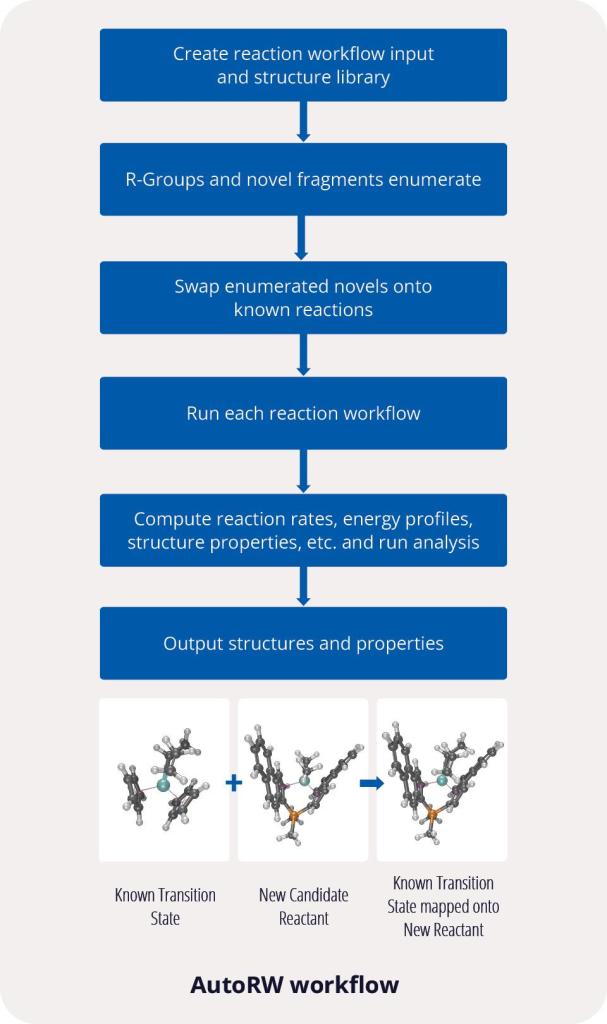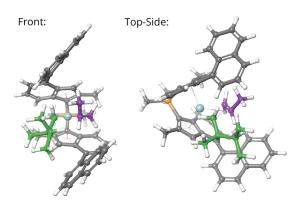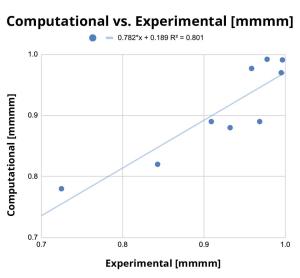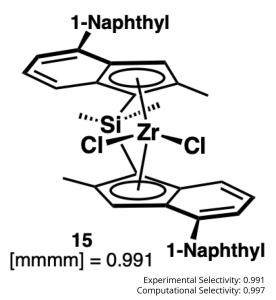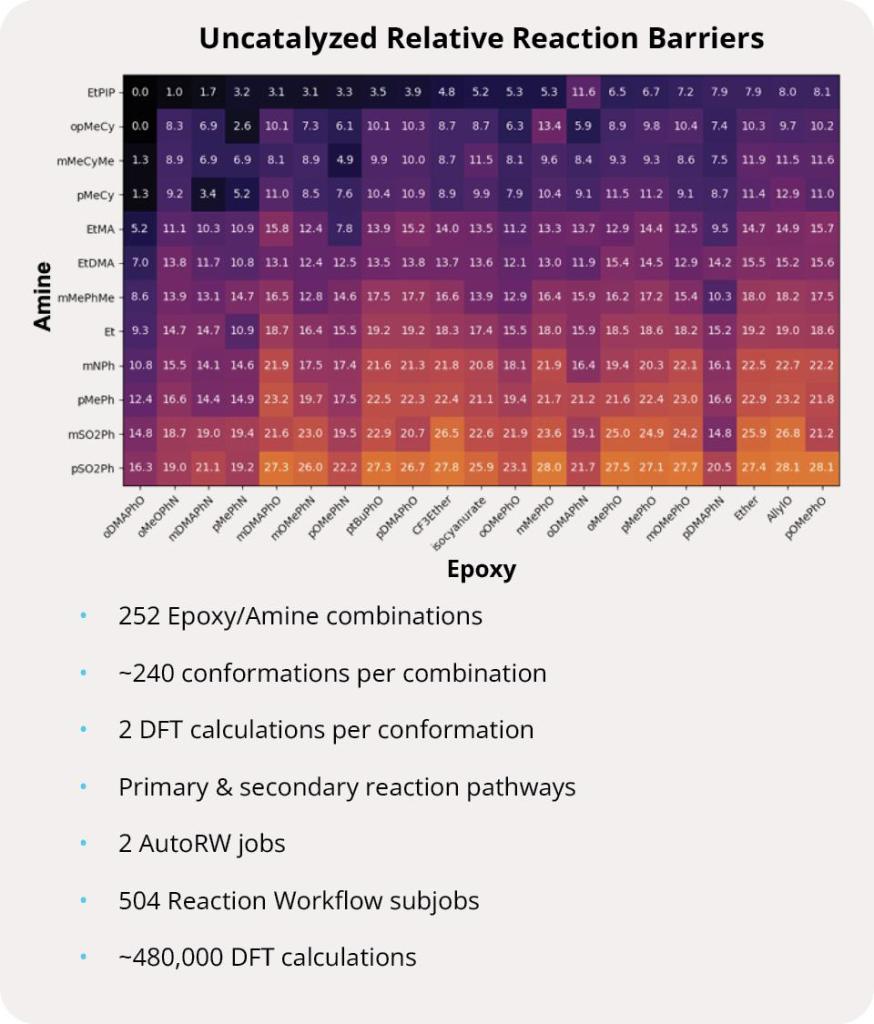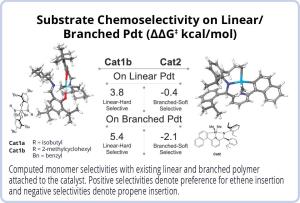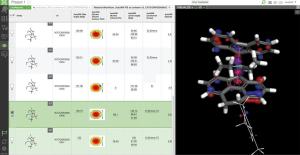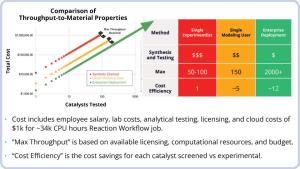An automated workflow for rapid large-scale computational screening to meet the demands of modern catalyst development
Executive Summary
First-principles simulation has become a reliable tool for the prediction of structures, chemical mechanisms, and reaction energetics for the fundamental steps in homogeneous catalysis. Details of reaction coordinates for competing pathways reveal a fundamental understanding of observed catalytic activity, selectivity, and specificity. Such predictive capability raises the opportunity to accelerate computational discovery and design of new single-site catalysts with enhanced properties.
However, along with the rapid technology development and materials innovation, challenges persist:
- The complexity of chemical reactions and the need for associated computational research has increased as demands for innovation increase
- The traditional rate of catalysts discovery is limited and unable to keep pace with demands for improved catalysts
- Existing computational frameworks are manually intensive with limited scale, and require a high level of expertise and training
- Cataloging and maintaining databases of novel catalysts is challenging and time-consuming
To democratize the fundamental understanding, design, and discovery of novel catalysts, Schrödinger developed an automated reaction workflow called AutoRW. AutoRW combines the elements of enumeration, mapping, organization, and output needed for high-throughput screening of catalysts, reagents, and substrates, requiring a pre-built reaction coordinate, novel chemical fragment, and any R-Groups for enumeration. By automating processes and computing the reaction coordinates, rates, energies, transition states, structures, properties, for each reaction, AutoRW streamlines the process of large-scale computational catalyst screening.
Solution: AutoRW for automated large-scale catalysts screening
- Simplified, customizable workflows that enhance reproducibility and predictability
- Easy to use for both expert and non-expert computational users
- Increased productivity for highly-complex problems and challenges
- Enhanced coverage where conformers could be missed by manual methods
- Improved organization of files and properties to save time and reduce errors
- Dedicated scientific & technical support and vast learning resources
Case Studies: How AutoRW Accelerates Innovation in Catalysis and Reactivity
Understanding the Effects of Catalysts Selectivity on Polypropylene Tacticity
Production of olefin-based polymer products has surpassed 100 million tonnes. Of these, polypropylene is the second most produced polymer. Its physical properties are directly influenced by the regularity of adjacent stereocenters. This regularity, or tacticity, is determined by the kinetic selectivity and the control of incorporation of α-olefin monomer allows for fine-tuning of its physical properties. In this project, scientists studied 13 isotactic catalysts using AutoRW to fundamentally understand the adjacent stereoselectivity of polypropylene. The results were in good agreement with the experimental selectivities (R2 = 0.8). This quick and accurate approach allows for optimized polypropylene design and synthesis with target structures and properties.
Screening Epoxy Amine Reactions for Efficient High-performance Polymer Design
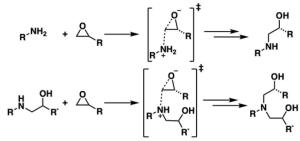
Thermoset polymers have gained interest in recent years due to their favorable thermomechanical properties for applications in aerospace, automotive, defense and high performance athletics equipment. While thermosets are very versatile, the cost to incorporate these polymers into new materials is high. Accelerating the development process pipeline would not only reduce costs, it would also decrease accumulation of thermoset waste which is difficult to recycle. Towards this end, the scientists studied a library of 12 amines and 21 epoxides to build a relative reaction barrier heat map. Each epoxy/amine combination was subjected to the Reaction Workflow to locate all stationary points in the reaction as well as compute energetic barriers for all reaction steps, enabling efficient design and synthesis of high-performance polymers.
Investigating Comonomer Selectivity for Optimized Block Copolymerization
Block copolymers have unique properties that include high strength, flexibility, and melting temperature. Their physical properties are directly influenced by the polymer block length and distribution, which are then determined by the kinetic comonomer selectivity and chain shuttling agent activity. The comonomer selectivity is influenced by both the catalyst and existing polymer product. In this project, scientists ran AutoRW to screen and test 35 catalyst derivatives with different polymer substrates to understand the effect of catalysts on comonomer selectivity for different copolymerization reactions. This approach enables quick screening of catalysts and substrates to design block copolymers with target structures and properties.
Empower advanced catalysts discovery across entire R&D project teams
As the modern R&D processes evolve in a more collaborative and globalized manner, tremendous effort has been put into data storage and sharing, communication and project management across teams and geographies. Enterprise scale informatics platforms for R&D have been developed to break the silos and barriers, and have been adopted by many companies across several molecular design industries.
The benefits are clear: project teams can work across departments and sites, across geographies and time zones, and even across companies, with live sharing of all the project data of experiments, designs, processes, simulations, etc.; Teams can share, analyze and communicate data seamlessly and make rapid decisions, accelerating the collaboration and progress of the projects. Enterprise informatics platforms also simplify and optimize data management for organizations, eliminating the chaos of storing large data on computer drives and transferring data between teams and during team or personnel changes.
Schrödinger’s LiveDesign is a powerful, web-based informatics and molecular design platform that enables teams to rapidly advance materials discovery projects by collaborating, designing, experimenting, analyzing, tracking, and reporting in a centralized platform. By incorporating AutoRW into LiveDesign, scientists can get the most benefits from both.
AutoRW in LiveDesign for enterprise-wide time and cost savings
- Streamlined automated enterprise solution for catalysis and reactivity
- Scalable to satisfy the need of large global organizations
- Integrated with advanced machine learning systems
- End-to-end collaborative discovery between chemists, modelers and engineers on a single web-based platform
- Live sharing of ideas and results for rapid decision-making
- Intuitive cheminformatics: visualization, data and model analysis for experimental and computational data simultaneously
Using LiveDesign, the team can collaborate and virtually screen over 2000 catalysts per year, while a single modeling user can only screen about 150 catalysts annually. Employing the automated enterprise-scale workflows lead to much higher cost efficiency and rates of success.
Conclusions
Scientists across industries are entering a new paradigm for catalysis research. Research historically based on pure experimental trial-and-error is moving to computationally-driven workflows. Rapid technology development and evolving project collaborations demand for simplified and automated workflows at enterprise scale. Schrödinger’s AutoRW and LiveDesign enable rational catalyst design in an automated, accelerated and collaborative manner on a single web-based platform, which are easy to use and deploy across teams and organizations.
The tools empower scientists to solve high-level challenges of even more complex reactions and catalysis systems with reduced time and cost while enhancing predictability and productivity.
Software and services to meet your organizational needs
Industry-Leading Software Platform
Deploy digital drug discovery workflows using a comprehensive and user-friendly platform for molecular modeling, design, and collaboration.
Research Enablement Services
Leverage Schrödinger’s team of expert computational scientists to advance your projects through key stages in the drug discovery process.
Scientific and Technical Support
Access expert support, educational materials, and training resources designed for both novice and experienced users.
